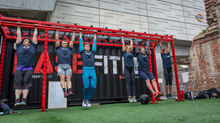Focus your training! NLP skills to help your training Part #1
- Andy Milne
- Apr 8, 2016
- 4 min read

Ever wondered how athletes motivate themselves every day to train, to eat healthily and stay focused on their relative goals, but most of all how they achieve what they do?
In this 3 part blog we'll be exploring the world of NLP (neuro linguistic programming) and what part it play's in the professional sports arena, and to teach you some of the techniques used.
So what is NLP firstly? Its a system formed back in the 1970's where the combination of hypnosis, linguistics and psycology gave amazing results and it soon become a cult in the 1980's onwards - favourable with sales men, trainers, teachers and coaches.
Why use it? Well NLP has many practical applications in everyday life. NLP has been proven to work to enhance the performance of athletes by focusing the mindset to win, changing restricting beliefs and managing motivation/ focus.
In this 3 part blog we'll be looking at these key techniques:
1. The godiva chocolate pattern - for managing motivation
2. The excitement zone pattern - to help manage your excitement to stay in the correct zone
3. Anchors - a marvellous technique to elicit a desired state of mind or emotion
4. Visualisation - these techniques help you visualise your goals and how to achieve them
5. Belief change - to help you overcome restricting beliefs
In this issue we'll tackle the largest and probably the most effective to start with.
BELIEF CHANGE: 30-45 minutes (use this template here)
I bet you can think of several beliefs you currently have that restrict you achieving great things or moving onto the next stage in life. This is where the belief change intervention comes in handy.
You'll need a pen, the sub-modalities check list template above and your visualisation skills on hand.
There are 4 steps to this.
Step 1: Ask yourself " do you have a belief that you wish you did not have? Good. Do you have a picture that represents this?
Now this is the key part. List everything you can on the sub-modalities check list about that picture. The colour, tone, size, clarity, distance, are you associated or dissociated, 3D or flat, movie or still image etc. Do the same with any sounds (auditory) and any feelings associated (Kinaesthetic). Think of every feature you can. These form the sub-modalities of your belief.
Step 2: Now do the same for a belief you know not to be true (i.e.. father Christmas exists) and map the sub-modalities in the same way as step 1.
Now what we need to do is to take the sub-modalities from the belief you do not wish to have and change the sub-modalities to mirror the belief you know not to be true. I.e. is the belief you no longer want dark yet the one you know not to be true is light. Then change the first belief to be lighter.
Now test you belief. How do you feel about the one you wished not to have? Have your emotions changed towards it, do you no longer believe in this belief thus no longer restricted by it? If not repeat step's 1 and 2 and try to list more sub-modalities and repeat the remapping. It's best done in a quiet environment so you can concentrate solely on the exercise at task.
We can take steps now to build a new belief by following the same processes for 'a belief you know to be true' and one you want to believe in replacement of your old belief.
Step 3: Think of a belief you now wish to hold, it could be personal, motivational or work related one - what we want to do is replace the belief you have just dissembled with a new more positive and functional one. Repeat step 1 by eliciting the sub-modalities as before to create a template.
Step 4: Now think of a belief you already hold as true. List the sub-modalities down in the same way as with Steps 1-3. Once done we want to map the new belief to mirror the one already known to be true. Is the image that's in the true belief in 3D?, yet the new one in flat screen? Change it to be 3D. Etc.
Now test you belief. How do you feel about the new one you have just created? Have your emotions changed towards it, do you now hold this belief to be true? How does it make you feel about carrying out this belief? Positively? If not repeat step's 3 and 4 and try to list more sub-modalities and repeat the remapping.
If this process has worked then you will now hold your new belief as true and real to you as in any other true belief you hold. Don't worry if it does not work, NLP works best on those who really wish things to happen, maybe you did not believe you could do this. Try working on that belief first and then repeat with your new one.
If you want further information please email me on andy@base-fit.uk.
Andy Milne
Master NLP practitioner and Sports coach.






































Comments